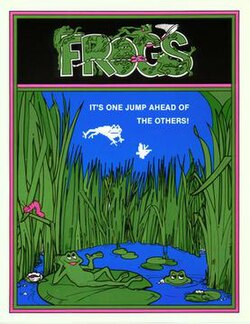This article needs additional citations for verification .(February 2010) |
| Frogs | |
|---|---|
 North American arcade flyer | |
| Developer | Gremlin Industries |
| Publishers | |
| Designer | Lane Hauck [2] |
| Platform | Arcade |
| Release | |
| Genre | Action |
| Mode | Single-player |
Frogs is a 1978 action video game developed and published by Gremlin Industries for arcades. It featured a jumping character (predating Donkey Kong by three years) [4] with graphics "projected" by laying the monitor flat on its back and reflecting the computer-generated graphics of the frogs and flies toward the player via a mirror at a 45-degree angle. The game's graphics were actually generated and shown backward, so the mirror reflection would show letters and numbers properly. [4] The game was distributed by Sega in Japan. [1]
